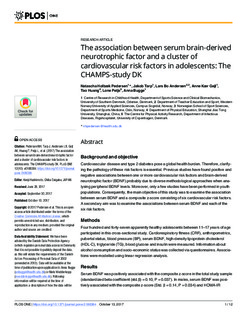| dc.contributor.author | Pedersen, Natascha Holbæk | |
| dc.contributor.author | Tarp, Jakob | |
| dc.contributor.author | Andersen, Lars Bo | |
| dc.contributor.author | Gejl, Anne Kær | |
| dc.contributor.author | Huang, Tao | |
| dc.contributor.author | Peijs, Lone | |
| dc.contributor.author | Bugge, Anna | |
| dc.date.accessioned | 2018-05-14T11:46:08Z | |
| dc.date.available | 2018-05-14T11:46:08Z | |
| dc.date.created | 2017-11-24T12:08:26Z | |
| dc.date.issued | 2017 | |
| dc.identifier.citation | PLoS ONE. 2017, 12, e0186384. | |
| dc.identifier.issn | 1932-6203 | |
| dc.identifier.uri | http://hdl.handle.net/11250/2498072 | |
| dc.description | This is an open access article distributed under the terms of the Creative Commons Attribution License, which permits unrestricted use, distribution, and reproduction in any medium, provided the original author and source are credited. | |
| dc.description.abstract | Background and objective: Cardiovascular disease and type 2 diabetes pose a global health burden. Therefore, clarifying the pathology of these risk factors is essential. Previous studies have found positive and negative associations between one or more cardiovascular risk factors and brain-derived neurotrophic factor (BDNF) probably due to diverse methodological approaches when analysing peripheral BDNF levels. Moreover, only a few studies have been performed in youth populations. Consequently, the main objective of this study was to examine the association between serum BDNF and a composite z-score consisting of six cardiovascular risk factors. A secondary aim was to examine the associations between serum BDNF and each of the six risk factors. Methods: Four hundred and forty-seven apparently healthy adolescents between 11–17 years of age participated in this cross-sectional study. Cardiorespiratory fitness (CRF), anthropometrics, pubertal status, blood pressure (BP), serum BDNF, high-density lipoprotein cholesterol (HDL-C), triglyceride (TG), blood glucose and insulin were measured. Information about alcohol consumption and socio-economic status was collected via questionnaires. Associations were modelled using linear regression analysis. Results: Serum BDNF was positively associated with the composite z-score in the total study sample (standardized beta coefficient (std.β) = 0.10, P = 0.037). In males, serum BDNF was positively associated with the composite z-score (Std. β = 0.14, P = 0.034) and HOMA-IR (Std. β = 0.19, P = 0.004), and negatively associated with CRF (Std. β = -0.15, P = 0.026). In females, BDNF was positively associated with TG (Std. β = 0.14, P = 0.030) and negatively associated with waist circumference (WC) (Std. β = -0.16, P = 0.012). Conclusion: Serum BDNF was positively associated with a composite z-score of cardiovascular risk factors. This association seems to be mainly driven by the association between TG, HOMA-IR and serum BDNF, and particularly for males. Further longitudinal research is warranted to determine the temporal relationship between BDNF and cardiovascular risk factors. | |
| dc.language.iso | eng | |
| dc.subject | adolescents | |
| dc.subject | alcohol consumption | |
| dc.subject | blood plasma | |
| dc.subject | insulin | |
| dc.subject | cholesterol | |
| dc.subject | insulin resistance | |
| dc.subject | blood pressure | |
| dc.subject | health risk analysis | |
| dc.title | The association between serum brain-derived neurotrophic factor and a cluster of cardiovascular risk factors in adolescents: The CHAMPS-study DK | |
| dc.type | Peer reviewed | |
| dc.type | Journal article | |
| dc.description.version | publishedVersion | |
| dc.rights.holder | © 2017 Pedersen et al. | |
| dc.source.journal | PLoS ONE | |
| dc.identifier.doi | 10.1371/journal.pone.0186384 | |
| dc.identifier.cristin | 1518098 | |
| dc.description.localcode | Seksjon for idrettsmedisinske fag / Department of Sport Sciences | |
| cristin.unitcode | 150,34,0,0 | |
| cristin.unitname | Seksjon for idrettsmedisinske fag | |
| cristin.ispublished | true | |
| cristin.fulltext | original | |
| cristin.qualitycode | 1 | |
